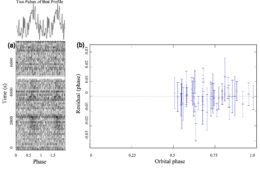Astronomers have discovered a second millisecond pulsar — a rapidly spinning, ultra-dense remnant of a massive star — in one of the nearest globular clusters to Earth. The new observations might help explain the surprising rarity of millisecond pulsars discovered in dense globular clusters.
Close Encounters of the Stellar Kind

Still image from an animation of a millisecond pulsar accreting material from its companion. [NASA]
Nearby globular cluster NGC 6397 — a glittering, spherical collection of 400,000 stars — is home to a curious binary system that has been detected at X-ray, optical, and ultraviolet wavelengths. Its X-ray emission flashes with the period of the binary orbit, and optical observations show a red star at the same location. Previous research has suggested that this system contains a millisecond pulsar, but the characteristic radio pulses have been elusive.

Left: Phase-folded radio observations from the Parkes Telescope, showing the characteristic radio signal of the newly confirmed pulsar. Right: Timing residuals as a function of orbital phase. The pulsar is not visible when the phase is between 0 and 0.5 and the pulsar is farthest from the observer. Click to enlarge. [Zhang et al. 2022]
In Pursuit of a Pulsar
In a new article, a team led by Lei Zhang (Chinese Academy of Sciences and Swinburne University of Technology, Australia) reports the results of their observations of the system made between 2019 and 2022 using the Parkes (Murriyang) radio telescope in Australia and the MeerKAT array in South Africa. Zhang and collaborators discerned faint but detectable radio pulses every 5.8 milliseconds, and the pulses were modulated with a period of 1.97 days — the same period as the orbital period of the X-ray-emitting binary system at the same location.
This confirms that the system contains a millisecond pulsar, dubbed NGC 6397B, and further analysis of the timing of the pulses suggests that the pulsar is also the source of the X-ray emission detected previously.
Implications of an Intermittent System

Orbital period and companion mass for millisecond pulsars (MSPs) discovered in globular clusters (filled circles) and in the field (empty circles). The black and gray symbols indicate whether the companion is a white dwarf (WD), main-sequence star (MS), or an ultralight or planet-mass object (UL). Click to enlarge. [Zhang et al. 2022]
Previous research has suggested that pulsars in binary systems should be common in globular clusters with exceptionally dense cores, like NGC 6397, but most known pulsars in so-called core-collapse clusters are singletons. The particulars of the newly discovered system may provide an explanation as to why pulsar-hosting binary systems have been elusive in these environments: pulsars in binary systems might have faint or intermittent radio emission, making them hard to track down.
Citation
“Radio Detection of an Elusive Millisecond Pulsar in the Globular Cluster NGC 6397,” Lei Zhang et al 2022 ApJL 934 L21. doi:10.3847/2041-8213/ac81c3
